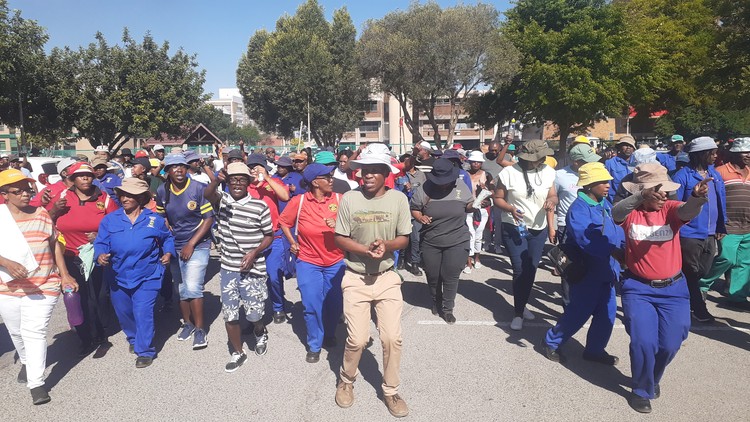Public sector hard hit by strike action
In 2023 and again in 2024, about half the strikes have been in the public sector, says report
Municipal workers on strike in Matjhabeng in October last year. About half of strikes last year, and again this year, have been in the public service, according to reportts by the Casual Workers Advice Office. Archive photo: Becker Semela
There were 83 strikes in 2023, about half of them in the public service, a report by the Casual Workers Advice Office (CWAO) shows. So far this year there have been 26 strikes, and again, half of them have been in the public sector.
According to the online live CWAO strike barometer, so far this year there have been seven strikes in provincial government and six in municipal government. The National Health and Allied Workers Union (NEHAWU), the National Union of Public Service and Allied Workers (NUPSAW) and the South African Municipal Workers Union (SAMWU) are the unions most concerned, and the strikes have taken place mostly in the Eastern Cape (10), KwaZulu-Natal (6) and Gauteng (6). Permanent jobs and wage increases have been the main demands.
In 2023 also, the public sector was hard hit by strikes, as workers protested against budget cuts.
“Forty-one of the 83 strikes occurred in the public sector. This figure excludes at least seven strikes at hospitals, universities, private companies contracted by municipalities, and institutions such as Productivity SA and the State Information Technology Agency,” said CWAO in its report.
The longest strike in 2023 was that of SAMWU workers against the City of Tshwane, which lasted more than 100 days as workers fought the municipality’s refusal to pay a 5.4% wage increase. This strike, like many of the others in the public sector, was a protected strike.
Municipal workers also went on strike last year in Emfuleni, in Gauteng, in Ladismith, in Rustenburg, in Makhanda, in Kimberley, in Makhado, in Welkom, in eThekwini, in Matjhabeng, and in Thembelihle, where workers from Orania, Hopetown and Strydenberg protested because they had not been paid following the resignation or suspension of several municipal executives.
The second longest strike in 2023, also protected, was in the private sector at Makro, where members of the South African Commercial, Catering and Allied Workers’ Union (SACCAWU) went on strike for 76 days over wage demands.
But on the whole, there were more “wildcat” strikes than protected strikes in 2023. Twenty-four unions were involved in these strikes, but in nine cases there seems to have been no union involvement, says the CWAO. “Recyclers, sex workers, domestic workers, Early Childhood Development Centre workers, Community Works Programme Workers and e-hailing workers from Uber and Bolt engaged in strike action.”
“Wildcat strikes have been significantly higher than protected strikes since 2018, according to the Department of Employment and Labour’s annual industrial reports.”
However, the number of strikes documented in 2023 is slightly lower than in 2022. “This,” says the CWAO, “continues the pattern of a relatively low number of strikes annually since the 165 strikes of 2018.”
Next: Children run a gauntlet of muggings and traffic on the way to school
Previous: Proposed coal mine in Mpumalanga grasslands back in court
© 2024 GroundUp. This article is licensed under a Creative Commons Attribution-NoDerivatives 4.0 International License.
You may republish this article, so long as you credit the authors and GroundUp, and do not change the text. Please include a link back to the original article.
We put an invisible pixel in the article so that we can count traffic to republishers. All analytics tools are solely on our servers. We do not give our logs to any third party. Logs are deleted after two weeks. We do not use any IP address identifying information except to count regional traffic. We are solely interested in counting hits, not tracking users. If you republish, please do not delete the invisible pixel.



